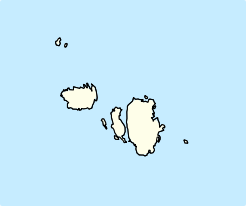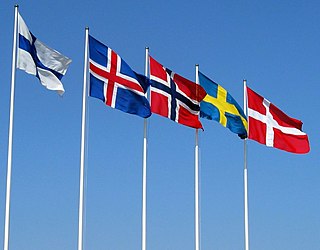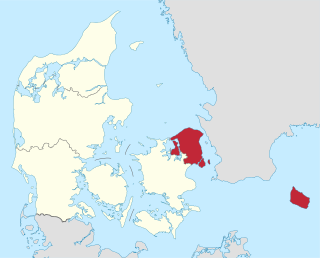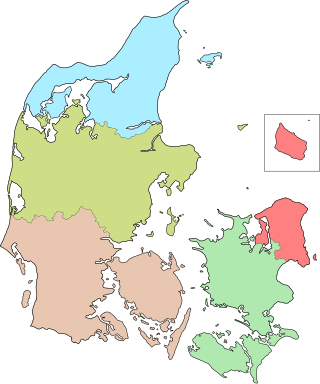
Bornholm is a Danish island in the Baltic Sea, to the east of the rest of Denmark, south of Sweden, northeast of Germany and north of Poland.

Scandinavia is a subregion of Northern Europe, with strong historical, cultural, and linguistic ties between its constituent peoples. Scandinavia most commonly refers to Denmark, Norway, and Sweden. It can sometimes also refer to the Scandinavian Peninsula. In English usage, Scandinavia is sometimes used as a synonym for Nordic countries. Iceland and the Faroe Islands are sometimes included in Scandinavia for their ethnolinguistic relations with Sweden, Norway and Denmark. While Finland differs from other Nordic countries in this respect, some authors call it Scandinavian due to its economic and cultural similarities.

Denmark is a Nordic country in the south-central portion of Northern Europe with a population of nearly 6 million; 767,000 live in Copenhagen. It is the metropolitan part of and the most populous constituent of the Kingdom of Denmark, a constitutionally unitary state that includes the autonomous territories of the Faroe Islands and Greenland in the North Atlantic Ocean. Metropolitan Denmark is the southernmost of the Scandinavian countries, lying south-west and south of Sweden, south of Norway, and north of Germany, with which it shares a short border.

Ertholmene is a small archipelago in Denmark. The largest island is Christiansø, whose name is often used with reference to the entire archipelago. Ertholmene are situated 18 kilometres (11 mi) northeast of Gudhjem, Bornholm, and include Denmark's easternmost point. Two of the islands, Christiansø and Frederiksø, are inhabited, with a combined permanent population of 91. The archipelago has a total area of 39 hectares. Its name is derived from the Danish for "pea islands".

Rønne is the largest town on the Danish island of Bornholm in the Baltic Sea. It has a population of 13,759. It was a municipality in its own right from 1970 until 2002, when Bornholm was a county. It has an area of 29.11 square kilometres, and is the administrative centre of the Bornholm municipality. As of 2018 11,539 inhabitants live in Rønne Parish, which is a narrow piece of land on the westernmost of the island and stretching north and southward comprising around a third of the area of the former municipality. Knudsker Parish made up the rest of the former municipality. Not all inhabitants of either Rønne or Knudsker (400-7553) parishes live in the city of Rønne.

Skåneland or Skånelandene (Danish) is a region on the southern Scandinavian peninsula. It includes the Swedish provinces of Blekinge, Halland, and Scania. The Danish island of Bornholm is traditionally also included. Skåneland has no official recognition or function and the term is not in common usage. Equivalent terms in English and Latin are "the Scanian Provinces" and "Terrae Scaniae" respectively. The term is mostly used in historical contexts and not in daily speech. In Danish, Skånelandene is used more often. The terms have no political implications as the region is not a political entity but a cultural region, without officially established administrative borders.

The Treaty of Roskilde was negotiated at Høje Taastrup Church and signed (NS) during the Second Northern War between Frederick III of Denmark–Norway and Karl X Gustav of Sweden in the Danish city of Roskilde. After a devastating defeat, Denmark–Norway was forced to give up a third of its territory to save the rest, the ceded lands comprising Blekinge, Bornholm, Bohuslän (Båhuslen), Scania (Skåne) and Trøndelag, as well as her claims to Halland.

Scanian is an East Scandinavian language spoken in the province of Scania in southern Sweden.

A Nordic cross flag is a flag bearing the design of the Nordic or Scandinavian cross, a cross symbol in a rectangular field, with the centre of the cross shifted towards the hoist.

The Capital Region of Denmark is the easternmost administrative region of Denmark, and contains Copenhagen, the national capital.

The five Regions of Denmark were created as administrative entities at a level above the municipalities and below the central government in the public sector as part of the 2007 Danish Municipal Reform, when the 13 counties (amter) were abolished. At the same time, the number of municipalities (kommuner) was cut from 270 to 98. The reform was approved and made into a law by the lawmakers in the Folketing 26 June 2005 with elections to the 98 municipalities and 5 regions being held Tuesday 15 November 2005.

Scanian law is the oldest Danish provincial law and one of the first Nordic provincial laws to be written down. It was used in the geographic region of Danish Skåneland, which at the time included Scania, Halland, Blekinge and the island of Bornholm. It was also used for a short period on the island of Zealand. According to some scholars, the Scanian Law was first set down between 1202 and 1216, around the same time it was translated into Latin by the Danish Archbishop Anders Sunesøn.
Bornholmsk is an East Danish dialect spoken on the island of Bornholm in the Baltic Sea. It was originally part of the East Danish dialect continuum, which includes the dialects of southern Sweden, but became isolated in the Danish dialect landscape after 1658, when Sweden annexed the eastern Danish provinces of Scania (Skåne), Halland and Blekinge.

The Danish Realm, officially the Kingdom of Denmark, or simply Denmark, is a sovereign state and refers to the area over which the monarch of Denmark is head of state. It consists of metropolitan Denmark—the kingdom's territory in continental Europe and sometimes called "Denmark proper" —and the realm's two autonomous regions: the Faroe Islands in the North Atlantic and Greenland in North America. The relationship between the three parts of the Kingdom is also known as The unity of the Realm.

Scania, also known by its native name of Skåne, is the southernmost of the historical provinces of Sweden. Located in the south tip of the geographical region of Götaland, the province is roughly conterminous with Skåne County, created in 1997. Like the other historical provinces of Sweden, Scania still features in colloquial speech and in cultural references, and can therefore not be regarded as an archaic concept. Within Scania there are 33 municipalities that are autonomous within the Skåne Regional Council. Scania's largest city, Malmö, is the third-largest city in Sweden, as well as the fifth-largest in Scandinavia.
The Bornholm Tunnel is a proposed railway tunnel which would be built between the island of Bornholm, belonging to Denmark, and Scania in Sweden. The tunnel would provide a fixed link to the island, both using direct trains running from Copenhagen and with a motorail service to transport automobiles. The tunnel would be 40 kilometers (25 mi) long and provide a one-hour transit time for cars, including loading and unloading, and a two-hour service by rail to Copenhagen via the Ystad Line and the Øresund Line. The latter could be further reduced with construction of high-speed rail in southern Scania.

Aarsdale is a village on the eastern coast of the Baltic island of Bornholm, Denmark. Located between Svaneke and Nexø, it has a population of 284. Once a prosperous fishing village, its economy now relies mainly on tourism thanks to its half-timbered houses, its harbour and its windmill.
Events from the year 1658 in Denmark.

Greenlandic independence is a political ambition of some political parties, advocacy groups, and individuals of Greenland, an autonomous territory within the Kingdom of Denmark, to become an independent sovereign state.

The Faroese independence movement, or the Faroese national movement, is a political movement which seeks the establishment of the Faroe Islands as a sovereign state outside of Denmark. Reasons for independence include the linguistic and cultural divide between Denmark and the Faroe Islands as well as their lack of proximity to one another; the Faroe Islands are about 990 km (620 mi) from Danish shores.
















